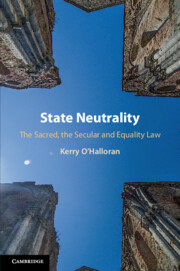Book contents
- State Neutrality
- State Neutrality
- Copyright page
- Dedication
- Contents
- Acknowledgements
- Introduction
- Part I Background
- Part II The Benchmark of State Neutrality
- 4 The United States of America: The Church–State Wall
- 5 Canada: Bijuralism
- 6 England: The Established Church
- 7 France: Laïcité
- 8 Germany: The Vaterland
- 9 Israel: Halakha and Zionism
- Part III Towards a More Stable Civil Society
- Conclusion
- Index
4 - The United States of America: The Church–State Wall
from Part II - The Benchmark of State Neutrality
Published online by Cambridge University Press: 15 January 2021
- State Neutrality
- State Neutrality
- Copyright page
- Dedication
- Contents
- Acknowledgements
- Introduction
- Part I Background
- Part II The Benchmark of State Neutrality
- 4 The United States of America: The Church–State Wall
- 5 Canada: Bijuralism
- 6 England: The Established Church
- 7 France: Laïcité
- 8 Germany: The Vaterland
- 9 Israel: Halakha and Zionism
- Part III Towards a More Stable Civil Society
- Conclusion
- Index
Summary
Models the structure and content for the five following jurisdiction-specific chapters, pointing out that the separation of church and state was established as an explicit requirement and explains the context that gave rise to the free exercise and anti-establishment clauses. Explores the policy background, outlines the contemporary relevant legal framework, as governed by statutory and constitutional provisions, noting the extent to which the country is a signatory state to relevant international law. Considers the genesis of the state neutrality principle in the anti-establishment clause as confirmed by decisions of the US Supreme Court. It delves into the religion-related case law to identify the principle’s bearing on the rights to freedom of religion, of conscience, expression and association, examines how it relates to equality law. It focuses on the various tests successively applied by the USSC in its efforts to police the church–state boundary. It identifies and discuses some different academic views, including the Habermas argument that “the principle of separation of Church and State demands that the institution of the State operates with strict impartiality”.
Keywords
- Type
- Chapter
- Information
- State NeutralityThe Sacred, the Secular and Equality Law, pp. 143 - 200Publisher: Cambridge University PressPrint publication year: 2021

